Journal Impact Factor is a rating that is given in a database called Journal Citation Reports.
The Journal Impact Factor rates journals on how often their published articles are cited over a 2-3 year period.
| Figure 1: Calculation for journal impact factor. |
|---|
| A= total cites in 2015 |
| B= 2015 cites to articles published in 2013-14 (this is a subset of A) |
| C= number of articles published in 2013-14 |
| D= B/C = 2015 impact factor |
Traditionally being cited is a way to measure the impact of your publication and the Journal Impact Factor helps you determine the likelihood that other scholars will see your work, read your work and reuse it.
Access to this information is through subscription only and UFV library does not have a subscription. There are other ways, however, to find out the journal impact factor of a journal.
If you choose any journal in ScienceDirect, you will find a link to the Elsevier publisher page of that particular journal.
There you will find the Journal Impact Factor as well as other ratings.
Go to:
At the top of the screen you will see the word "Journals." Go there and find the journal of your choice.

For our example here we will search The Lancet.
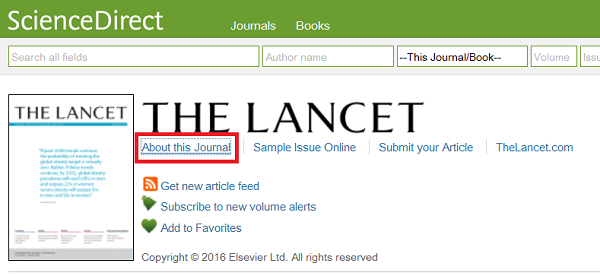
Choose "About this Journal" and you will be taken to the publisher's homepage.
Scroll down and on the left you will find the Impact Factor.

In 2015, the Lancet had a journal impact factor of 45.217 --that means that the average article was cited 45 times in the two years after publication.
A little tip:
It is hard to find which journals have the highest impact factor when you are just browsing.
If you google "journal impact factor" site:elsevier.com you will probably find journals with higher ratings.
If you go to:
Choose Browse>By Discipline and limit to Sage Journals Available to me (which means your students will be able to access your publication online once you are published).

You will find that with some of their journals they give the Impact Factor.
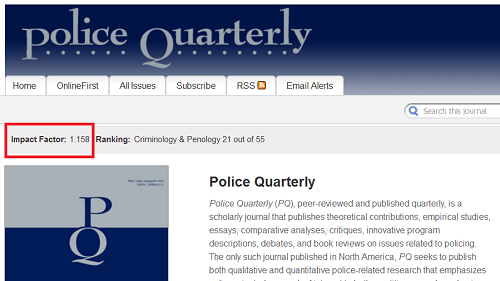
A little tip:
It is hard to find which journals have the highest impact factor when you are just browsing.
If you google journal impact factor site:.sagepub.com you will probably find journals with higher ratings.
If you go to:
And Browse Journals. Limit the search to Journals only.
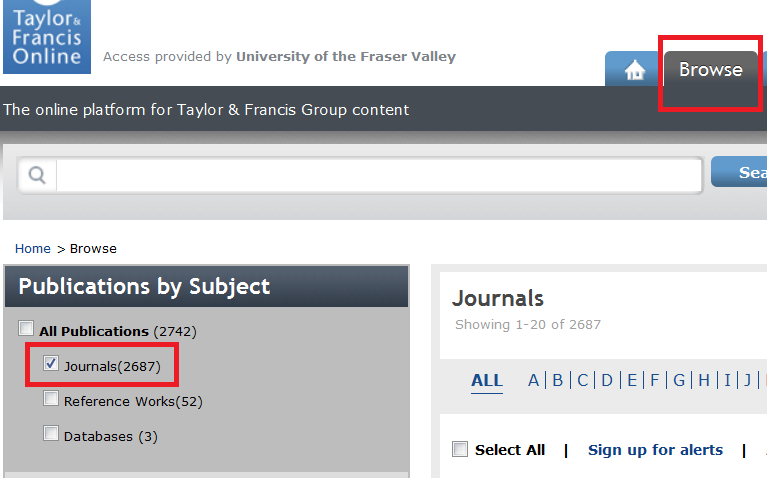
Some of the journals will give their Impact Factor, but not all.
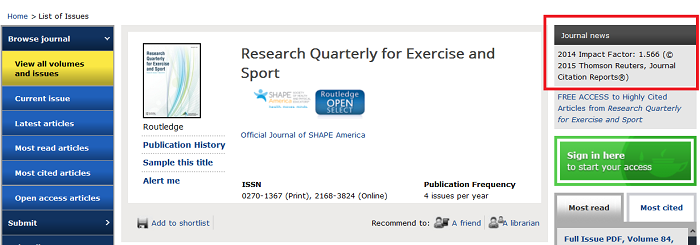
If you click on the Most Cited articles you can also find other Altmetrics.
A little tip:
It is hard to find which journals have the highest impact factor when you are just browsing.
If you google journal impact factor site:tandfonline.com you will probably find journals with higher ratings.
If you go to:
Browse by Discipline and untick the Preview Only box (again you want your students to be able to access your article once it has been published). Finally limit by Article.
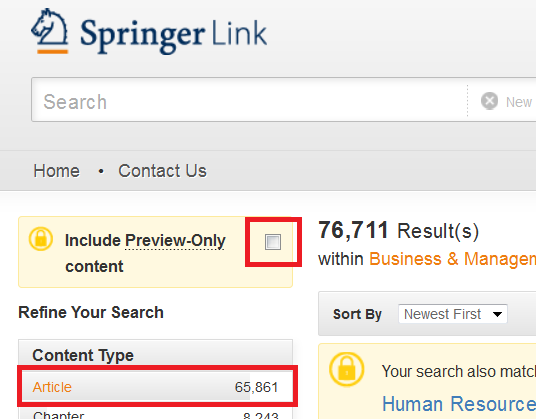
You will find Journal Impact Factor.

A little tip:
It is hard to find which journals have the highest impact factor when you are just browsing.
If you google journal impact factor site:.link.springer.com you will probably find journals with higher ratings. To limit to your subject area try adding it: e.g. humanities journal impact factor site:.link.springer.com
If you go to:
And browse the journals:

Choose your title:

A little tip:
It is hard to find which journals have the highest impact factor when you are just browsing.
If you google journal impact factor site:.oxfordjournals.org you will probably find journals with higher ratings. To limit to your subject area try adding it: e.g. humanities journal impact factor site:.oxfordjournals.org
If you go to:
And browse the journals:
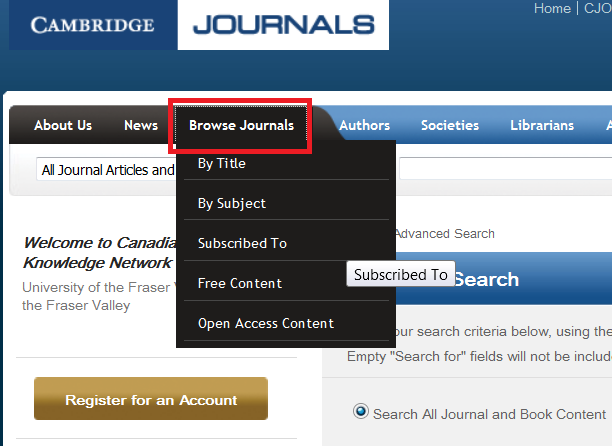
Choose the title you are interested in:
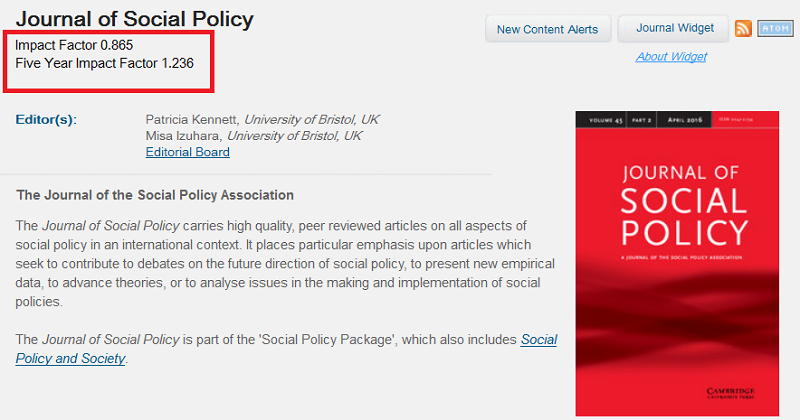
A little tip:
It is hard to find which journals have the highest impact factor when you are just browsing.
If you google journal impact factor site:http:journals.cambridge.org you will probably find journals with higher ratings.
Altmetrics was one of the first companies to realize that just following number of citations is not the only way to judge the impact of your article. You can follow how many people tweet about your article, or how many consider it valuable enough to put in a citation database like Mendeley.
If you use our library search you will find that Altmetric ratings are included with the citation.
For example:

Google provides a free tool to assess the relative importance of a scholarly journal. The metrics rank journals overall, and within subject disciplines, by providing an h5-index rating. “h5 index is the h- index for articles published in the last 5 complete years. It is the largest number h such that h articles published in 2009- 2013 have at least h citations each.” (Google Scholar Metrics). For example, a journal with an h5 index score of 355 has 355 papers that have been cited 355 or more times each. Google Metrics includes journals in the Humanities, Social Sciences and Sciences.
The Eigenfactor website is a valuable free resource which provides an Eigenfactor Score, an Article Influence Score and a Cost Effectiveness score for journals. It is searchable by journal title, ISSN, publisher, ISI subject category and Eigenfactor subject category and includes journals in the sciences and social sciences.
The Eigenfactor methodology shares similarities with the JCR method, but uses a 5 year time span to analyze citing patterns. Full details on the algorithms used are available at http://www.eigenfactor.org/methods.pdf
An open source altmetrics service where you can track your scholarly impact.
Another free alternative to Journal Citation Reports is the SCImago Journal Rank (SJR), produced using data from Elsevier’s Scopus database. SJR includes journals in the sciences and social sciences, and can be searched by journal title or browsed by discipline. Users can compare a custom list of journals. A number of indicators are provided, including the SJR indicator, H index, Cites per Document, and Self - Citations, and journal lists can be sorted by various indicators. The SJR indicator is a complicated formula which weights the citations based on the importance or prestige of the journal doing the citing.
You will notice with some articles within various databases different types of information is available: how many people have cited your article (usually within that particular database); how many people have downloaded your article and more.
Here's some examples.
This is from SpringerLink
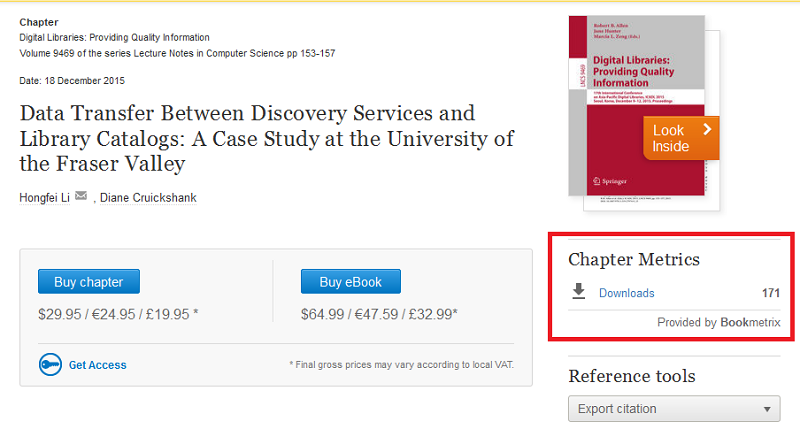
This is from ScienceDirect:

© , University of the Fraser Valley, 33844 King Road, Abbotsford, B.C., Canada V2S 7M8

